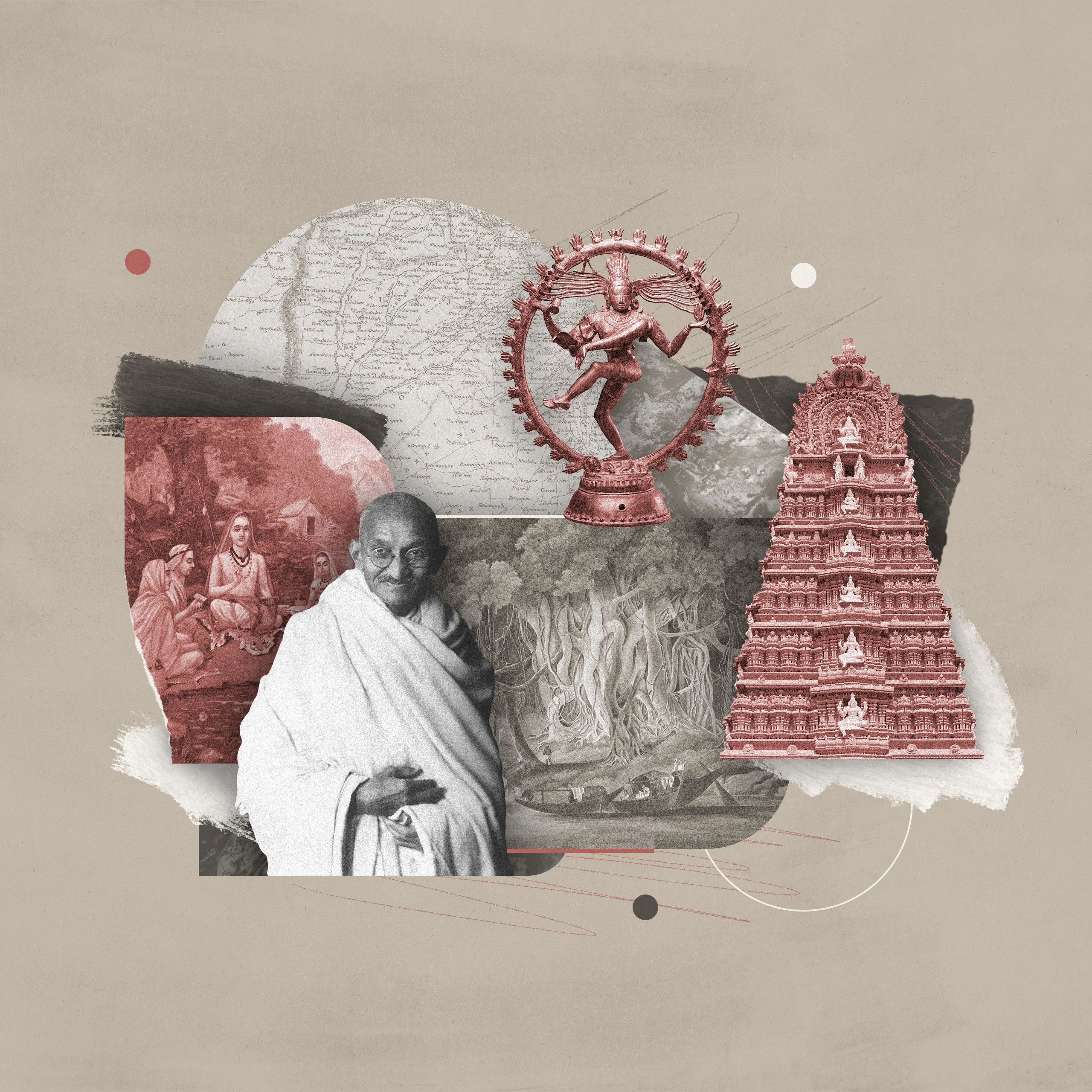What Is Hinduism?

What is Hinduism?
The religion known as Hinduism is actually a collection of several associated religious traditions that originated in ancient India. The third-largest religion in the world, Hinduism today has more than nine hundred million adherents. Like Buddhism, Hinduism is a monistic religion, which means that it sees all reality as ultimately one. Hindus seek oneness with the Ultimate Reality or Spirit (Brahman). Unlike Buddhism, modern Hinduism tends toward henotheism. Henotheism is the worship of one supreme god, together with manifestations (i.e., avatars) of that god in a plurality of gods and goddesses.1 In Hinduism, religion and society are inseparably connected in a caste system—a fixed social hierarchy. There are four main branches of Hinduism: Vaishnavism, Shaivism, Shaktism, and Smartism. However, Hinduism is an incredibly large and diverse religion, and there is much variety of belief and practice within each of its main branches.
When did it begin?
The word Hindu refers to the land and inhabitants surrounding the Indus River. References to this region in Hindu scriptures have led scholars to conclude that northern India was the birthplace of Hinduism. The absence of a single founding figure distinguishes Hinduism from almost every other world religion. While Hinduism has a set of sacred writings, they are not viewed as divine revelation in the same way that Christians view the Bible as divine revelation or in the way Muslims affirm that the Qur’an is divine revelation. Hinduism originated between 2000 and 1500 BC, making it one of the world’s oldest religions. Hindu beliefs and practices originally spread and were passed down via oral tradition. The earliest body of Hindu sacred writings is the Vedas—from a Sanskrit word meaning “knowledge” or “wisdom”—which take the form of ancient hymns. The Vedas comprise four books—the Rig-Veda, Sama-Veda, Yajur-Veda, and Atharva-Veda. The Rig-Veda is the most ancient of the Vedas. The concluding portions of the Vedas, known as the Upanishads, cover philosophical topics and are the foundational texts for most Hindu spiritual study. The most well-known Hindu text is the Bhagavad Gita, which is part of the ancient Hindu epic Mahabharata. The Bhagavad Gita contains the essence of Hindu devotional teaching.
Who are the key figures?
The eighth-century philosopher Adi Shankara unified Hinduism through a careful study of the Vedas and Upanishads. He is author of the Hindu saying “Atman is Brahman,” which encapsulates the idea that each individual soul (atman) is finally one with the Ultimate Spirit (Brahman).
The nineteenth-century monk Swami Vivekananda represented Hinduism at the World Parliament of Religions in Chicago in 1893. He brought about significant reform in the caste system.
Mohandas Gandhi is arguably the most well-known Hindu to modern people. He is renowned for his teaching on nonviolent civil disobedience to achieve social and political reform in India in the early to mid-twentieth century.
Among popular figures, the Beatles’ George Harrison was a Hindu convert, as are actress Julia Roberts and actor Russell Brand.
What are the main beliefs?
-
One and many gods. Hindus believe in one impersonal god or Ultimate Reality—Brahman—while affirming the existence of a plurality of gods and goddesses. There are three chief manifestations of Brahman—Brahma, Vishnu, and Shiva—from whom all other gods and goddesses are incarnate manifestations. Brahma, the creator god, is largely ignored in modern Hinduism, while Vishnu, the preserving god, and Shiva, the destroying god, have many worshipers. Many Hindus also render their primary devotion not to Vishnu or Shiva but to Shakti, a feminine representative of Brahman that manifests herself as many different goddesses. For all practical purposes, popular Hindu devotion identifies Vishnu, Shiva, or Shakti as Brahman depending on the Hindu tradition followed. All Hindus believe that Brahman manifests itself in a multitude of avatars—earthly incarnations of gods and goddesses. It has often been said that there are 330 million gods and goddesses (avatars) in Hinduism. This number should not be taken literally but “is an exaggeration meant to emphasize the multitude of the gods.”2
-
Dharma. The concept of dharma is central to Hinduism. Although it is difficult to translate, dharma represents Hindu duty, conduct, law, order, religion, virtue, justice, and morality. It plays a significant role in the Indian caste system. Each caste has its own rules and regulations by which members must abide. Dharma is related to karma and the cycle of rebirth or reincarnation, as faithful observance of particular duties is necessary for moving into a higher caste in the next life. A person may not move out of the caste, essentially one’s social class, into which he was born during his lifetime.
The third-largest religion in the world, Hinduism today has more than nine hundred million adherents.
- Karma. The doctrine of karma is the backbone of the religious and social system of Hinduism.3 Karma says that whatever someone has—whether physical appearance, financial status, personality, health, or sorrow—is a result of his past life. One goes through the cycle of reincarnation based on his dharma in a previous life. If someone gives himself to vice and moral degeneration, he will not be destroyed or cease to exist. Rather, he will continue in the cycle of reincarnation—as long as necessary—until his soul reaches nirvana and he becomes one with the Ultimate Reality. If someone lives a life of bad dharma, he will be reborn in a lower caste or as a lower life form in the next cycle.
Why do people believe this form of false teaching?
The spread of Hinduism is due in large part to its antiquity and to its comprehensiveness. Its ideology encompasses the totality of an individual’s familial, social, and religious life, making departure difficult and costly. The Brahmins (priests and teachers of the highest caste) exercise power over the lives of those in lower castes, confining them in the system. In the Western world, elements of Hinduism have spread through the popularity of yoga in gyms and exercise programs. Western popular culture has also long been fascinated by Eastern religions such as Hinduism. For instance, the Beatles popularized Hindu ideas through their travels to India and their advocacy of Hindu-influenced Transcendental Meditation during the 1960s.
How does it hold up against biblical Christianity?
-
Only one God. Contrary to Hinduism, the Bible reveals that there is only one true and living God. This true God is a personal being. He does not change (Mal. 3:6). The one God subsists in three persons—the Father, Son, and Holy Spirit—who are each fully divine and yet distinct from one another according to each one’s unique personal property. The Son is not an avatar of the Father, and the Father did not become the incarnate Son. Rather, the person of the Son of God united a sinless human nature to His eternal divine nature, thereby becoming the God-man. The Father, Son, and Spirit eternally exist as the one true God. When the New Testament speaks of the members of the Godhead, it places them side by side, distinguishing them according to their personal properties while maintaining that they are identical in terms of the one divine essence (1 Cor. 8:6; 12:4–6; 2 Cor. 13:14; 2 Thess. 2:13–14; 1 Peter 1:2; 1 John 5:4–6; Rev. 1:4–6).
-
Law and grace. The Bible contains prescriptive duties, laws, rituals, and principles of virtue, justice, and morality. In His law, God reveals His will for the conduct of His people. However, no one is saved by attempting to keep the law. All people, except Christ, are fallen and unable to please God by nature (Rom. 3:10–20; 5:12–21) and are under God’s wrath and curse (Gal. 3:13). In Adam, we are dead in sin and depravity and need a salvation from outside ourselves. God initiates, procures, and provides salvation entirely by His grace. There is no grace in Hindu teaching. People are rewarded or punished exclusively on the basis of good or bad dharma. According to Scripture, God redeems a people for Himself based on the merit of Jesus Christ, the eternal Son of God, who—as our representative—kept the law perfectly and took the punishment we deserve. In Christ, God forgives, accepts, and reconciles believers to Himself (1 Cor. 1:30).
-
Death, judgment, and salvation. Death is a result of the sin of Adam. God will judge men for what they have done in this life. Apart from grace, we are subject to the eternal wrath of God because of sin (Rom. 1:18; Eph. 5:6; Col. 3:5–6; Rev. 19:15). Only those who trust in Christ will gain eternal life (John 3:16–18). As the writer of Hebrews explains, “It is appointed for man to die once, and after that comes judgment, so Christ, having been offered once to bear the sins of many, will appear a second time, not to deal with sin but to save those who are eagerly waiting for him” (9:27–28).
How can I share the gospel with those who hold to this false teaching?
-
Focus on sin and judgment. When witnessing to Hindus, explain that sin is not, first and foremost, a violation of social norms or an offense against one’s caste. Sin is primarily an offense against God (Gen. 39:9; Ps. 51:4). Since Hindus typically think of punishment for sin in terms of social degradation and not as justice incurred for a personal offense against the Creator, it is vital to help them think properly about the eternal ramifications of sinning against the eternal God. Scripture is full of references to eternal death and judgment on sin (Gen. 2:17; Ps. 5:5; 11:5; 50:21; 94:10; Rom. 1:18; 2:3; 6:21, 23; Gal. 3:10; Eph. 2:3).
-
Focus on forgiveness of sins in Christ. Hindus—especially those in lower castes—spend their lives seeking to work their way out of the caste system. Many are burdened with the weight of their failings. Hindus need to hear about the forgiveness that God freely gives in Christ. Jesus said, “Come to me, all who labor and are heavy laden, and I will give you rest” (Matt. 11:28). Explain that God took the punishment for our sin in the person of Jesus Christ (2 Cor. 5:21). Share God’s promises of forgiveness to all who trust in Jesus alone for salvation (Ex. 34:6–7; Ps. 130:4; Jer. 31:34; Dan. 9:9; Acts 5:31; 13:38; 26:18; Rom. 4:7; Eph. 1:7; Col. 1:14).
-
Focus on Jesus as Mediator. Man’s great need is to be reconciled to God. The Bible teaches that reconciliation happens only through the mediatorial work of Jesus Christ (2 Cor. 5:19). As God and man, Jesus bridges the gap between the infinitely holy God and sinners. Jesus died on the cross to bring us to God (1 Peter 3:18). Jesus is the Great High Priest of believers. He “always lives to make intercession for them” (Heb. 7:25). Jesus is the only Mediator. He said: “I am the way, and the truth, and the life. No one comes to the Father except through me” (John 14:6). Paul also explained, “There is one God, and there is one mediator between God and men, the man Christ Jesus” (1 Tim. 2:5).
-
Wendy Doniger, “Hindu Pluralism and Hindu Tolerance of the Other,” in Israel Oriental Studies XIV: Concept of the Other in Near Eastern Religions (New York: E.J. Brill, 1994), 370. ↩
-
Winfried Corduran, Neighboring Faiths (Downers Grove, Ill.: InterVarsity Press, 1998), 201. ↩
-
Seth Govinda Das, Hinduism, cited by Paul Pathickal in Christ and Hindu Diaspora (Bloomington, Ind.: WestBow, 2012), 47–48. ↩


